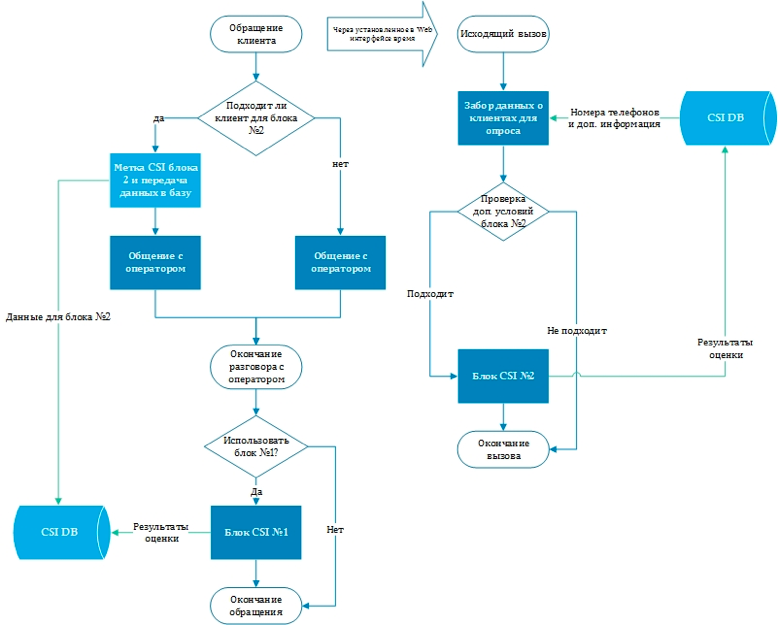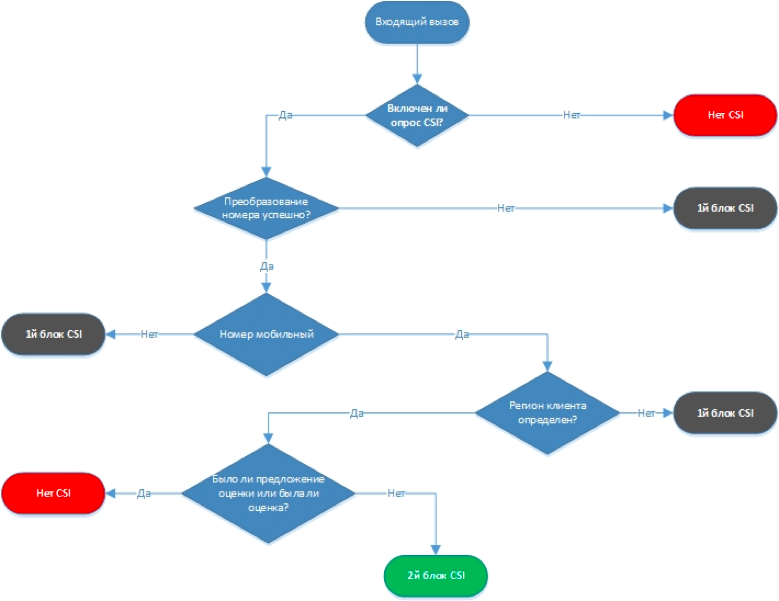Customer Satisfaction Assessment
You can evaluate the work of the contact center operator not only by the company's internal standards (completeness of information provision or speech literacy, call duration, etc.), but also directly by the client's response. This is a necessary component for understanding the real level of quality of service. Below is information on how this is done in Yota.
We measure the quality of customer support with the help of CSI (Customer Satisfaction Index) - customer satisfaction index. At the moment, it is calculated on the basis of the client’s assessment of the parameters of the operator’s work. To do this, after contacting the Contact Center, the client is asked to answer three questions. The customer survey and the collection of estimates for calculating the CSI index are implemented on the Asterisk Open Source platform, which is used for the entire intelligent telephony of our CC. Its functionality allows us to realize ideas on our own and satisfy the needs of the company.
Here I will talk about the device for collecting ratings of the work of the operators of the Yota Contact Center.
')
Interview with an incoming call (immediately after the end of communication with the operator) - on the diagram Block 1.
The outgoing call for polling (the time after which the call will be made is configured in the web interface) - on the block 2 diagram.

First, the phone number is analyzed, converted to the classic 10-digit view, the region of the client is determined. Next, it checks whether the client is already in the queue for an outgoing call, and if he did not answer questions earlier (for the interval configured in the web interface). It is also checked whether he was offered to give a rating, even if he did not accept the offer (for the interval that is configured in the web interface). After a complete check of these conditions, the customer number is placed in a queue for calling in the future. If he is already in the queue and called again, then the time of the call with the survey for him is shifted to the preset time (also configured in the web interface). If, as a result of the check, at least one condition is not fulfilled, then the survey is carried out immediately after communicating with the operator (method # 1) or is not performed at all.

When it was the turn to make a call to this client, the system checks additional indicators, for example, how long the client talked to the operator and whether he spoke at all (perhaps the client found the answer to the question and hung up). Also, on the basis of the region, the local time of the client is checked and compared with the allowed time for an outgoing call (configured in the web interface).
Then a call is made to the client, and based on the call status information, the system decides whether to call the client or not, and after what time to call back if necessary (all parameters are customizable).
If the client does not like this method of polling (for example, he called and informed about it), then his phone number will be entered in the list of exceptions, and the next time he is called, Method # 1 will be applied to him.
After connecting with the client, he is asked 3 questions on which he will be able to assess the quality of service on a scale from 1 to 5 (checking the correctness of the answer: if, for example, the client made a mistake and rated at 9, then he will be asked again). All customer responses are collected in a database, and automated reports for their further processing and analysis are built on their basis.
The screenshot below shows which parameters of the system, mentioned earlier, can be changed via the web interface:

Receiving such a large amount of data is important feedback for the Yota Contact Center. We ask the client only three questions, the answers to which can tell a lot to the manager. The assessment is carried out on a scale from 1 to 5. First of all, we will find out if the user's question has been resolved, and then about whether he liked the work of the operator. For us, the ratio of this pair of ratings is important. According to them, it is possible to identify the best operators, who, with a high average score, have rare cases when these assessments are different - that is, even if the issue is not resolved during the talk time, the operator does everything to resolve it even after the call. There is one more question for the client - about the “labor intensity” index. The user is asked whether he has spent a lot of effort to resolve the issue. Not everyone has to delve into the computer settings under the guidance of the operator, even if the hitch, for example, the slow work of the Internet, is in them. Therefore, the combination of high marks for resolving the issue and the goodwill of the operator with a low “labor intensity” index is a signal that the issue needs to be solved differently.
We measure the quality of customer support with the help of CSI (Customer Satisfaction Index) - customer satisfaction index. At the moment, it is calculated on the basis of the client’s assessment of the parameters of the operator’s work. To do this, after contacting the Contact Center, the client is asked to answer three questions. The customer survey and the collection of estimates for calculating the CSI index are implemented on the Asterisk Open Source platform, which is used for the entire intelligent telephony of our CC. Its functionality allows us to realize ideas on our own and satisfy the needs of the company.
Here I will talk about the device for collecting ratings of the work of the operators of the Yota Contact Center.
Principle of operation
Even before transferring the call to the operator, the system performs a comprehensive check of the call and selects the method of polling the client. There are 2 ways:')
Interview with an incoming call (immediately after the end of communication with the operator) - on the diagram Block 1.
The outgoing call for polling (the time after which the call will be made is configured in the web interface) - on the block 2 diagram.

Method number 1
It is used in cases when a customer calls from a mobile phone, that is, with high probability next time he will pick up the phone.First, the phone number is analyzed, converted to the classic 10-digit view, the region of the client is determined. Next, it checks whether the client is already in the queue for an outgoing call, and if he did not answer questions earlier (for the interval configured in the web interface). It is also checked whether he was offered to give a rating, even if he did not accept the offer (for the interval that is configured in the web interface). After a complete check of these conditions, the customer number is placed in a queue for calling in the future. If he is already in the queue and called again, then the time of the call with the survey for him is shifted to the preset time (also configured in the web interface). If, as a result of the check, at least one condition is not fulfilled, then the survey is carried out immediately after communicating with the operator (method # 1) or is not performed at all.

When it was the turn to make a call to this client, the system checks additional indicators, for example, how long the client talked to the operator and whether he spoke at all (perhaps the client found the answer to the question and hung up). Also, on the basis of the region, the local time of the client is checked and compared with the allowed time for an outgoing call (configured in the web interface).
Then a call is made to the client, and based on the call status information, the system decides whether to call the client or not, and after what time to call back if necessary (all parameters are customizable).
Call statuses
Possible statuses:- The conversation took place
- Customer busy
- The client did not respond (within a set period of time - usually 30 seconds)
- Customer hung up
- Connection error
If the client does not like this method of polling (for example, he called and informed about it), then his phone number will be entered in the list of exceptions, and the next time he is called, Method # 1 will be applied to him.
After connecting with the client, he is asked 3 questions on which he will be able to assess the quality of service on a scale from 1 to 5 (checking the correctness of the answer: if, for example, the client made a mistake and rated at 9, then he will be asked again). All customer responses are collected in a database, and automated reports for their further processing and analysis are built on their basis.
The screenshot below shows which parameters of the system, mentioned earlier, can be changed via the web interface:

Total
The use of this system in Yota began in February, and its full implementation lasted six weeks. About 80% of all collected estimates were received by Method # 2 (outgoing call). Its use made it possible to increase the number of estimates received: for the first month, 70% of the total number of such outgoing calls ended with an assessment of the level of service. While in global practice, the response rate in customer satisfaction surveys ranges from 30 to 60 percent, depending on the channel. It is lower if the survey was conducted by e-mail, and above if it is a phone call.Receiving such a large amount of data is important feedback for the Yota Contact Center. We ask the client only three questions, the answers to which can tell a lot to the manager. The assessment is carried out on a scale from 1 to 5. First of all, we will find out if the user's question has been resolved, and then about whether he liked the work of the operator. For us, the ratio of this pair of ratings is important. According to them, it is possible to identify the best operators, who, with a high average score, have rare cases when these assessments are different - that is, even if the issue is not resolved during the talk time, the operator does everything to resolve it even after the call. There is one more question for the client - about the “labor intensity” index. The user is asked whether he has spent a lot of effort to resolve the issue. Not everyone has to delve into the computer settings under the guidance of the operator, even if the hitch, for example, the slow work of the Internet, is in them. Therefore, the combination of high marks for resolving the issue and the goodwill of the operator with a low “labor intensity” index is a signal that the issue needs to be solved differently.
Source: https://habr.com/ru/post/184632/
All Articles